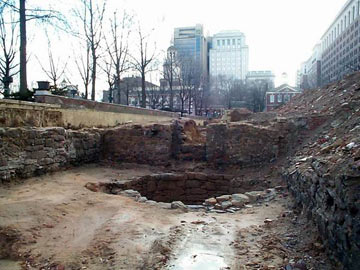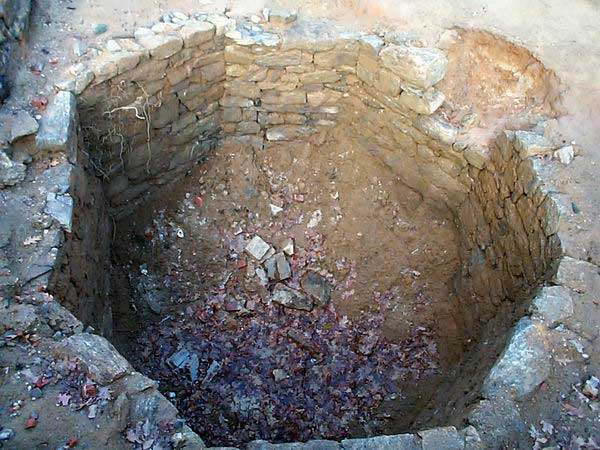The First Icehouse in America?

1785 map overlaid with the Liberty Bell Center footprint (blue). The Slave Quarters are shown in red. 2002 National Park Service map, with additions by Ed Lawler.
by Independence National Historical Park, National Park Service

National Park Service
The ice pit was a stone-lined octagon 13 feet in diameter and 18 feet deep. Many tons of ice were cut from a nearby river in winter, transported by wagon to the icehouse, and deposited into the ice pit. The blocks of ice fused into one giant mass. Gravel at the bottom of the pit drained water from melting, and thick stone walls and straw insulation minimized heat-loss from the icehouse above. Morris claimed that he was able to preserve ice from one winter to the following October or November.
Morris's icehouse was almost certainly based on a European model. George Greive, a British lawyer who became a French citizen, visited Philadelphia in 1782 and observed:
"The house ... in which Mr. Morris lives, belonged formerly to Mr. Richard Penn; the Financier has made great additions to it, and is the first who has introduced the luxury of hot-houses, and ice-houses on the continent."– Marquis de Chastellux; Travels in North America in the Years 1780, 1781 and 1782, English translation by George Greive, revised translation and notes by Howard C. Rice, Jr., (University of North Carolina Press, 1963), vol. 2, p. 300.

National Park Service
The icehouse Greive recorded was brand new. Morris had leased the Richard Penn house only the year before, so the icehouse must have been built during 1781. The diary of Joseph Hiltzheimer documents what was probably the first filling of the ice pit:
"February 12, [1782]. — Loaned Robert Erwin a wagon and two horses to assist in bringing ice from the Schuylkill [River] to the ice-house of Robert Morris in the rear of his house on Market Street."George Washington was a frequent houseguest of the Morrises, and seems to have been fascinated by the icehouse. He sought advice from Morris, who wrote this detailed description of how the icehouse was constructed and functioned:– Diary of Jacob Hiltzheimer, ed. Jacob Cox Parsons, (William F. Fell & Co., 1893), p. 48.
"My Ice House is about 18 feet deep and 16 square, the bottom is a Coarse Gravell & the water which drains from the ice soaks into it as fast as the Ice melts, this prevents the necessity of a Drain ... the Walls of my Ice House are built of stone without Mortar (which is called Dry Wall) untill within a foot and a half of the Surface of the Earth when Mortar was used from thence to the Surface to make the top more binding and Solid. When this Wall was brought up even with the Surface of the Earth, I stopped there and then dug the foundation for another Wall, two foot back from the first and about two foot deep, this done the foundation was laid so as to enclose the whole of the Walls built on the inside of the Hole where the Ice is put and on this foundation is built the Walls which appear above ground and in mine they are ten foot high. On these the Roof is fixed, and these walls are very thick, built of Stone and Mortar, afterwards rough Cast [stuccoed] on the outside. I nailed a Ceiling of Boards under the Roof flat from Wall to Wall, and filled the Space between the Ceiling and the Shingling of the Roof with Straw so that the heat of the Sun Cannot possibly have any Effect.Washington constructed an icehouse at Mount Vernon based on Morris's model. In 1790, Morris's house at 6th & Market Streets became the executive mansion of the United States while Philadelphia served as the 10-year temporary national capital. The icehouse was utilized by President Washington and his household until 1797, and by President John Adams and his household from 1797 to 1800. The national capital moved to Washington, D.C. and the Adamses into the White House in November 1800.In the Bottom of the Ice House I placed some Blocks of Wood about two foot long and on these I laid a Plat form of Common Fence Rails close enough to hold the Ice open enough to let the Water pass through, thus the Ice lays two foot from [above] the Gravel and of Course gives room for the Water to soak away gradually without being in contact with the Ice, which if it was for any time would waste it amazingly. The upper Floor [the floor of the icehouse] is laid on joists placed across the top of the Inner well and for greater security I nailed a Ceiling under those Joists and filled the Space between the Ceiling and Floor with Straw.
The Door for entering this Ice house faces the north, a Trap Door is made in the middle of the Floor through which the Ice is put in and taken out. I find it best to fill with Ice which as it is put in should be broke into small pieces and pounded down with heavy Clubs or Battons such as Pavers use, if well beat it will after a while consolidate into one solid mass and require to be cut out with a Chizell or Axe. I tried Snow one year and lost it in June. The Ice keeps until October or November and I believe if the Hole was larger so as to hold more it would keep untill Christmas..."
– Robert Morris to George Washington, June 15, 1784, George Washington Papers, Series 4, General Correspondence, Library of Congress.
The stone-lined octagonal ice pit of Robert Morris's icehouse was uncovered by archaeologists from John Milner Associates in November 2000. This 18th century technological marvel was reburied, and lies beneath the floor of the new Liberty Bell Center.




